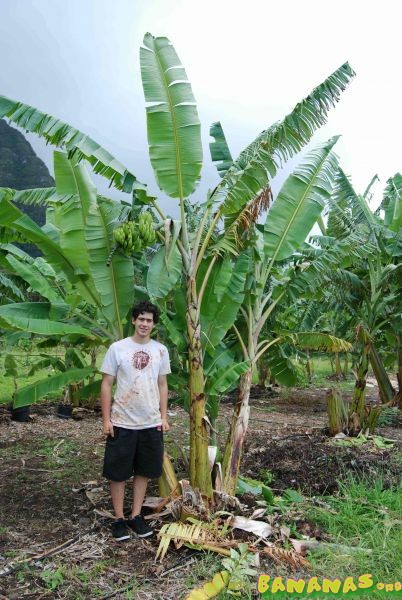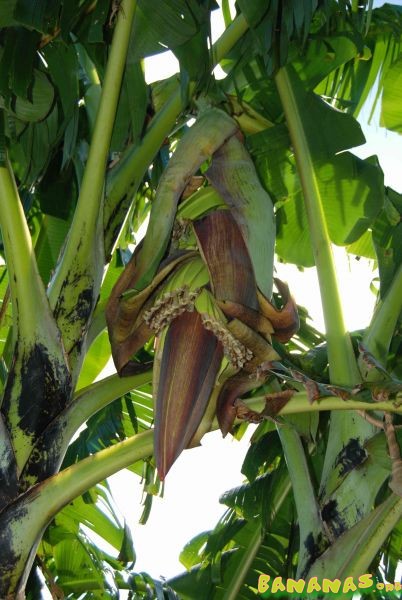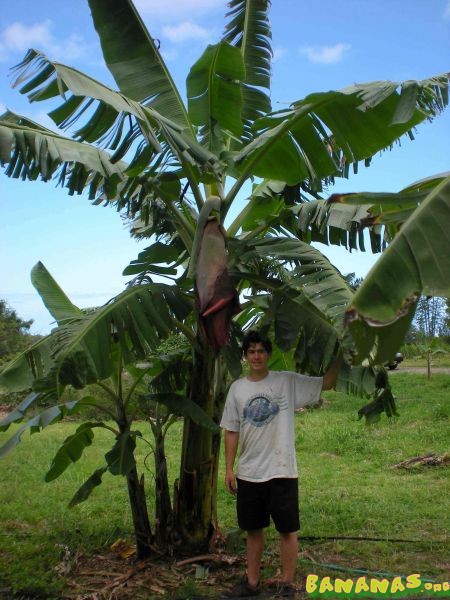With a busy schedule during the school semester, I don't often get the chance to upload and share photos with everyone.
I'm gone from Hawaii for the summer, and the photos below are from this past year on the student farm I help to run. Almost all of the plants pictured were planted last March (2009), with a few exceptions which were planted about 6 months earlier ('Pisang Jari Buaya' and 'Pama'). I selected each variety based on uniqueness and potential for being useful to the farm. I planted a wide diversity initially with the knowledge that they will be slowly thinned out to the few varieties that make it. So far, we have lost a few to banana bunchy top virus (BBTV) and removed one due to poor performance. There are a few clear standouts though, and those we will plant more of while continuing to experiment with new varieties. So far, there about 40 varieties in the ground on the farm, with another 10 or so ready to go when the next spot opens up.
I have organized them in this thread so that somewhat closely related varieties appear together.
AA Genome
Pama:
A very small, very slow growing diploid of Papua New Guinea. As far as fruit goes, for us it made a very small bunch, of very small fruit that ripen with yellow skin and orange flesh which are most palatable when cooked. I wouldn't keep it for its fruit, but it has some potential as an ornamental of sorts due to its extremely inhibited suckering habit, slow growth, interesting form and bold red color.

 Pisang Jari Buaya
Pisang Jari Buaya:
The 'Crocodile Fingers' and 'Monkey Fingers' of common hobby trade, this interesting diploid has fruited twice so far. I was unable to try any fruit from the first bunch, but the second one just started a few weeks, perfect timing for harvest when I return to Hawaii after the summer.

 Muraru Mshale
Muraru Mshale:
This African diploid produces relatively large bunches, of 8-10in fruits with an intensely thick and aromatic pulp. Flavor and texture-wise, it is very reminiscent to me of the famed 'Gros Michel' bananas, though perhaps even more flavorful with an even firmer texture to it. Its brother 'Muraru Mulalu' is likely similar, though as of yet I've only sampled the Mshale.


 Muraru Mulalu
Muraru Mulalu:


 AB Genome
Kunnan
AB Genome
Kunnan:
This diploid from India is a small, slender plant with good fruit. Nothing special flavor-wise, its good eating but nothing stands out. I would like to use it in breeding, but Banana Bunchy Top Virus may get to it before I do at this point.

 AAA Genome
Cocos
AAA Genome
Cocos:
Though I have planted two different accessions of "normal" 'Gros Michel', I also have planted two dwarf forms. This one, 'Cocos', grows only to about 8-9ft rather than the 15-20ft 'Gros Michel'. Though a shorter plant, the bunch and fruit size remain uncompromised, yielding a large bunch of excellent fruit.

 Inyoya
Inyoya:
One of a few East African Highland bananas that I planted. In East Africa, these are generally regarded as cooking bananas, though I have found they also make excellent dessert bananas. This types are often, very wide and round with a moist and tangy pulp. I had tried some before that I didn't grow, and was really looking forward to harvesting this bunch, but a band of thieves came in and cut bunch a good 2-3 months premature. Luckily its been fairly vigorous and a bunch or two should be hanging upon my return.

 AAB Genome
Exera
AAB Genome
Exera:
If you've ever been to Hawaii, you've probably had the local 'Apple' bananas. Those are in fact what is called 'Brazilian' and 'Dwarf Brazilian' on the mainland. This cultivar is of the same subgroup, Pome (sometimes also called Prata). I have not had the fruit yet, but would guess it to be sweet and slightly acidic like other members of the subgroup.

 Kifutu
Kifutu:
This Pome banana from Africa is interesting in that it almost tastes like a mix between common Pome types and a Cavendish. Less acidic with more of the classic banana aromatic component. A relatively quick, grower, this plant took less than 10 months to fruit the first time.

 Kingala
Kingala:
One of three Silk subgroup bananas we have grown. The common Silk banana of the US is 'Manzano', and this is similar. Some Silks seem to have problems here, often being difficult to predict ripening because the fruit will be full bright yellow, fingers falling off the hand, skins splitting, and still being chalky and under-ripe. I'm hoping to find a Silk that behaves in a decent manner in this regard.

 "Igisihira"
"Igisihira":
This was supposed to be another East African Highland, but its obviously a mislabeled Silk. I'm not sure where the mixup occurred, it could potentially be another Kingala like above, but I'm still growing it out to find out how it acts.
 Ungoye Sweet
Ungoye Sweet:
This short Silk type, although being one of the fastest growers (8 months from planting to shooting), had consistently been a poorly ripening plant. The fruit was dry and pithy with a persistent astringency. Perhaps this could be corrected by leaving the bunch on longer, but then the risk of animals getting to it as it ripens dramatically increases among other issues. I figure I already have two other Silk types, and if this one was going to be so tricky to produce a quality fruit, then it's not worth keeping. We took it out and replaced it with the dwarf Gros Michel cultivar 'Highgate'.
 Auko
Auko:
An interesting plant from Papua New Guinea, ideal for cooking. Its likely very closely related to 'Vunapope' (below). These plants are strange in that looking at them, they are very reminiscent of wild M. balbisiana, but with edible fruit. Flow cytometry has determined them to AAB, an interesting result given its strong resemblance to ABB types. In any case, I like these bananas for their drought tolerance and vigor. They are short, fat and starchy, thus lending themselves wonderfully to making tostones from a single fruit.


 Vunapope
Vunapope:

 Kluai Roi Wi
Kluai Roi Wi:
This is the Thai name for what we commonly know as '1000 Fingers' or 'Pisang Seribu'. My bunch didn't make it past about 2-3ft of female fruits before reverting back to male flowers. The pups are cut because the plant is infected with BBTV and I didn't want it to be an active host site for the aphids which transmit the virus. This plant has since been removed and replaced with an 'Orinoco'. I originally planted it to show off banana diversity, fruit-wise I don't think its worth growing due to its extremely small fruit (1-2in) and difficult to deal with bunch.

 ABB Genome
Kayinja
ABB Genome
Kayinja:
This Pisang Awak subgroup member from East Africa is currently a popular replacement for the traditional beer-brewing cultivars there. We use it as a dessert banana, being practically identical to the common 'Namwah'. It is extremely vigorous and I plan on planting more. One drawback is the occasional presence of pithy fruit, I've only had this happen once from a different plant, but ours seem to be coming out fine so far.


 false 'Ney Poovan'
false 'Ney Poovan':
I don't know the true name of this plant, it was acquired as 'Ney Poovan' (a diploid AB, like 'Kunnan' above), but it is obviously some type of Pisang Awak. It is smaller than 'Kayinja' with a few slight floral differences. The biggest difference in fruit is that this plant actually has fruit with an interesting rubbery texture. They are crisp and bite off easily, but if you try to break off a piece for a friend to try, you end up just bending it into a U. We haven't sold any yet, but when we do I'm think of calling it the "Gummy Awak". Any other suggestions?


 AAAB Genome
Goldfinger
AAAB Genome
Goldfinger:
The famous FHIA-1 has been a fun plant to watch grow. I planted two plants on the same day, they flowered within a few days of each other and produced one of the larger female buds I've seen, certainly the largest on the farm. The fruit is looking good so far, I think I'll miss these bunches but they should be fruiting again before too long.



